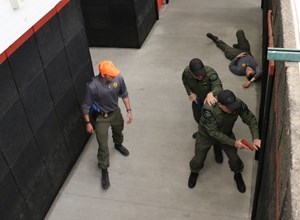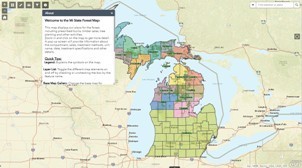|
Here's a look at some of this week's stories from the Department of Natural Resources:
See other news releases, Showcasing the DNR stories and photos and other resources at michigan.gov/dnrpressroom.
 Wondering what kinds of snakes we have here in Michigan and how to tell the difference? Find out with our 60-Second Snakes video series on the DNR’s YouTube channel!
Michigan is home to 18 different snake species, but there’s no need to worry, since most found here are harmless and tend to avoid people. If you do spot a snake, give it space to slither away, and you likely won’t see it again. Handling or harassing snakes is the most common reason people get bit.
Simply put, if left alone, Michigan snakes will leave people alone.
While most snakes in Michigan aren’t dangerous, there is one venomous species found here – the eastern massasauga rattlesnake.
As the name implies, the massasauga rattlesnake has a segmented rattle on its tail. But keep in mind that other Michigan snakes – even those without segmented rattles – also may buzz or vibrate their tails when approached or handled.
“The massasauga rattlesnake tends to be a very shy snake that will avoid humans whenever possible,” said Hannah Schauer, wildlife communications coordinator with the DNR. “They spend most of their time in wetlands hunting for small rodents and aren’t often encountered. In fact, this snake is listed as a threatened species.”
Rattlesnake bites, while extremely rare in Michigan, can and do occur. Anyone who is bitten should seek immediate medical attention.
Snakes play an important role in ecosystem health by keeping rodent numbers in check and, in turn, feeding larger predators, especially hawks and owls. Help monitor Michigan’s reptile and amphibian populations by reporting your sightings to our Herp Atlas database. Visit miherpatlas.org to get started.
Learn more about snakes on the DNR website or contact Hannah Schauer at 517-388-9678.
|
 While at a Great Lakes port this summer and fall, you might see one of the DNR’s four large fisheries research vessels conducting annual surveys of Great Lakes fish populations. The vessels are based out of Marquette, Alpena, Charlevoix and Harrison Township harbors, and the DNR staff aboard these vessels do a variety of work to better understand the fish communities, population sizes and habitats in these waters.
Fisheries assessment and evaluation work on Lake Huron is done by the research vessel (R/V) Tanner, launched in 2016. This vessel focuses on Lake Huron lake trout and walleye populations, and spends time in Saginaw Bay and the St. Marys River to evaluate their fish communities.
Work on lakes St. Clair and Erie is done by the R/V Channel Cat, now marking its 50th year of service! This vessel helps researchers learn about walleye, yellow perch and lake sturgeon in the waters that support some of Michigan’s busiest fishing activity.
Lake Superior work is conducted by the R/V Lake Char, launched in 2007. The Lake Char assesses the status of Lake Superior’s self-sustaining lake trout populations along with other members of the unique cold-water fish community found in that area.
On Lake Michigan, the survey vessel Steelhead, launched in 1967, focuses on adult yellow perch, whitefish, lake trout and chinook salmon populations.
When these unique vessels are in port, feel free to visit and talk with the crews about their work. Learn more by visiting michigan.gov/fishresearch or contacting Gary Whelan at 517-284-5830 or Elyse Walter at 517-284-5839.
|
 DNR conservation officers now are federally certified in responding to active shooter attacks, enhancing their abilities to protect Michigan citizens.
The DNR is one of the few agencies in Michigan to earn this certification. All 232 conservation officers completed the intensive, 16-hour training at the Camp Grayling Joint Maneuver Training Center. The program, certified by the U.S. Department of Homeland Security, instructs officers on the latest tactics for responding to attacks on places like schools, places of worship and employment centers.
“Conservation officers are fully certified peace officers who may be called upon to respond to active shooting situations,” said Gary Hagler, chief of the Law Enforcement Division. “All too often we see these incidents of terrorism play out on our televisions across America. These are real, dangerous situations, and the need for a rapid, coordinated response is imperative to stopping the threat as soon as possible.”
Hagler said the training gives officers the most relevant information and tactics that have proved successful in previous incidents. He said the decision to undergo training was made last year and is not a response to any recent threats.
|
"DNR conservation officers are assigned to every county in Michigan," Hagler said. "This type of training will allow us to interact more effectively with other agencies."
Cpl. Brad Dohm, the department’s lead firearms instructor, said the course addressed technical aspects of planning and implementing a rapid law enforcement deployment, highlighted by classroom presentations, hands-on, performance-based field training and scenario-based practical exercises.
Dohm and his team of instructors earned certification as active shooter response course trainers in 2017 by working with professionals from Louisiana State University’s renowned Academy of Counter-Terrorist Education. The instructors then rolled out the training to their conservation officer colleagues.
The entire 16-hour course also is being incorporated into the DNR Conservation Officer Recruit School curriculum.
For more on the federal training, contact Lt. Steve Burton at 517-284-5993. Learn more about Michigan conservation officers, including qualification requirements, training and responsibilities, at michigan.gov/conservationofficer.
 The DNR has launched a new, interactive online map to help the public better understand plans for different areas of Michigan’s state forests.
The map makes it easier to find information on timber sales, prescribed burns and other management activities. You can navigate on the map or simply type in an address to find out what activities are being planned or getting started in your area of interest. The current map highlights planned activities that will occur in 2020, the current “year of entry” – which means the department right now is discussing and planning for actions that will take place in 2020. Next year, in 2019, forestry staff will work on actions for the next year of entry, 2021.
“This really makes it easier for people to learn well in advance about what we’re doing to manage the forest for timber production, creation of wildlife habitat, or removal of invasive species – actions that will keep our forest healthy,” said Brian Maki, the DNR’s geographic information systems support manager.
The map is part of the DNR Forest Resources Division’s commitment to involving the public in proposed state forest management activities. People also may offer public comment at upcoming open houses in each of the 15 management units in the northern Lower Peninsula and Upper Peninsula.
Find the map under Public Input on the michigan.gov/forestry webpage. The DNR welcomes feedback to improve users’ experience, so if you have suggestions on making interaction with the map better, please email dnr-gis@michigan.gov.
The DNR manages 4 million acres of state forest and houses a crew of geographers and data managers who provide up-to-date information on forest health, wildlife populations and more.
To explore the DNR’s maps and data that are available to you, visit michigan.gov/dnrmaps. Questions? Contact Brian Maki at 517-284-5846.
|
 Fisheries staff in the northern Lower Peninsula have been busy tagging muskellunge in the Inland Waterway in an effort to gain better insight into the area’s populations. The Inland Waterway is a roughly 38-mile series of rivers and lakes connecting Lake Huron and Lake Michigan. Anglers who catch any muskies in the area are encouraged to report it, particularly if a fish has an external tag or any evidence that a tag was on the fish at some point.
Tagging these fish allows the DNR to learn a lot about the area’s population: things like fish growth and densities, spawning locations, exploitation, and how recent fishing regulation changes are affecting them.
“We’re trying to gather data to be better managers of our Inland Waterway muskie populations,” said Tim Cwalinski, a DNR fisheries biologist out of Gaylord. “This is hopefully a multiple-year project where we’ll have a better idea of what the population actually looks like and how we need to adapt our management over time.”
This is the third year that local muskies have received tags – one in the form of a button tag on the cheek, and the other located on the back dorsal fin. Some fish may be missing one or both of the tags due to tag shedding, which is another aspect of the study. If a tag is present, anglers will see a tag number and phone number to report the catch. Anglers are encouraged to report all Inland Waterway muskellunge catches to the DNR.
As a reminder, all muskie that are caught and kept (harvested) must be registered either at michigan.gov/registerfish, over the phone, or at a DNR customer service center.
For more information, visit michigan.gov/muskie or contact Tim Cwalinski at 989-732-3541 or Elyse Walter at 517-284-5839.
|
 Looking for the perfect Father’s Day gift? Make his day with one of these Michigan-inspired items. And since the proceeds from many of these purchases are reinvested back into the state’s natural and cultural resources, these are gifts that give twice:
- Consider state park, trail and waterway bottles, hoodies, coffee mugs and other ideas that honor dad while paying tribute to our woods and waters. Learn more at goods4mi.com.
- Help dad get a shot at winning a hunting prize package worth more than $4,000, including licenses for elk, bear, spring and fall turkey, antlerless deer and first pick at a managed waterfowl hunt area – with a Pure Michigan Hunt application. Visit michigan.gov/pmh.
- Before there was Pure Michigan, there was Say Yes to Michigan! Get your wardrobe summer-ready with a throwback T-shirt featuring Michigan tourism campaign slogans from days past. Visit michiganology.com.
- The campers and boaters on your list will love the idea of planning their next camping or boating trip in state parks and harbors. Plastic gift cards can be purchased by calling 517-284-6110 and eGift cards can be purchased online.
- Take dad to the nearest license retailer and purchase a fishing or hunting license together. Licenses also are available for purchase online (just remember to have the gift recipient’s driver's license number handy).
|
PHOTOS AVAILABLE: High-resolution versions of many of the above images (and others) are available in this photo folder.
|